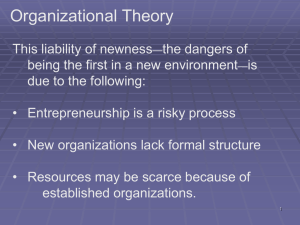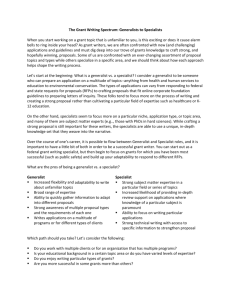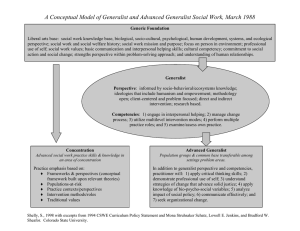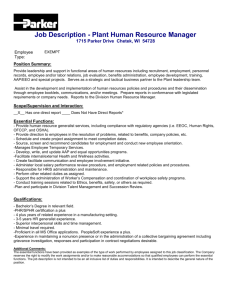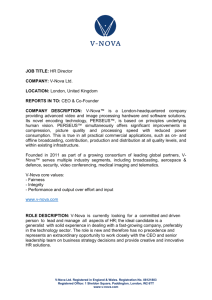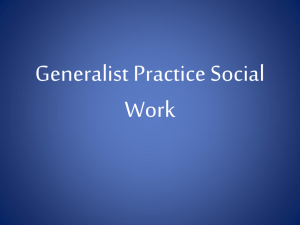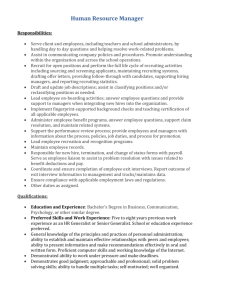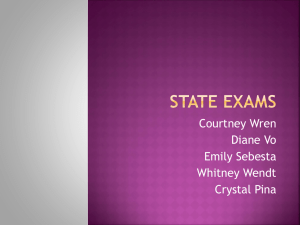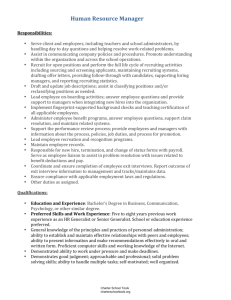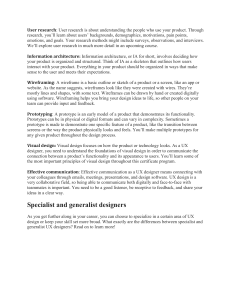Human Resource Champions: The Next Agenda for Adding Value
advertisement
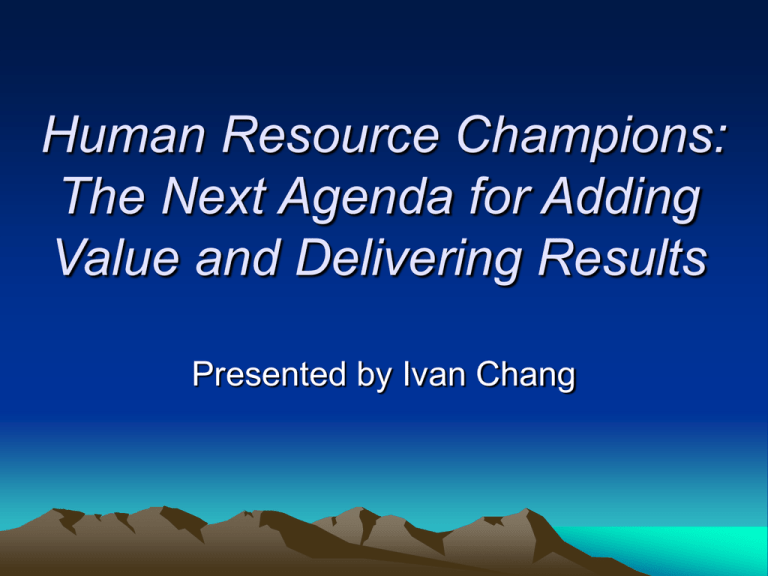
Human Resource Champions: The Next Agenda for Adding Value and Delivering Results Presented by Ivan Chang The changing nature of Human Resources: a model for multiple roles • • • • • • • Operational to strategic Qualitative to quantitative Policing to partnering Short-term to long-term Administrative to consultative Functionally oriented to business oriented Internally focused to externally & customerfocused • Reactive to proactive • Activity-focused to solutions-focused A multiple-role model for HR management Future/strategic focus Management of strategic Human resources Management of transformation & change process people Management of Firm infrastructure Management of employee contribution Day to day/operational focus Definition of HR roles Role/cell Deliverable/ Metaphor Outcome Activity Management of Executing strategic strategy Human resources Strategic partner Aligning HR & business strategy: “organizational EX: Marriott diagnosis” 5day workweek Hong Kong Management of Firm infrastructure Building an efficient infrastructure Administrative expert Reengineering org. processes: staffing, developing, assessing Management of employee contribution Increasing employee commitment & capability Employee champion Listening & responding to employees: “providing resources to employees” Management of transformation and change Creating a renewed organization Change agent “Ensuring capacity for change” Identifying & framing problems, building relationships of trust creating & fulfilling action plans What’s Next • What’s So? • So What? • Now What? What’s So? • How organizations can build competitiveness? • HR Professionals must become partners with other senior managers by creating value and delivering results • People will always need to be hired and trained; process will always need to be created and upgraded; culture will always need to be established and transformed • HR policies and practices should create organizations that are better able to execute strategy, operate efficiently, engage employees, and manage change • HR practices create organizational capabilities that lead to competitiveness So What? • HR professional is the employees’ voice, catalysts and facilitators and designers of both culture change and capacity for change • Line managers is primarily responsible for HR practices within a firm • Line managers bring authority, power, and sponsorship; HR professionals bring technical expertise; Staff professionals bring technical expertise in their functional areas; Venders offer technical advice or perform routine standardized work HR Community: A series of Partnerships Line Managers HR Professionals Staff Professionals Venders (consultants, sub-contractors, outsourcing partners) Now What? • HR community will be propelled by seven challenges for the future: – HR Theory – HR tools – HR capacities – HR value proposition – HR governance – HR careers – HR competencies Challenge one: HR Theory • Resource dependence: deal with scarce resource • Transaction cost: reduce the costs associated with accomplishing and governing how work is done • Contingency theory: align with business strategy to provide a fit that leads to results • Institutional theory: transfer knowledge and ideas from firm to firm making the best practices of an industrial routine • Cognitive psychology: help to create a shared mindset or culture within the firm that reduces governance costs and increases commitment Challenge two: HR Tools • Late 1970s: four core HR activities – Staffing, development, appraisal, and rewards • Global HR: different country’s hiring, compensation, benefits, training; global thinking and strategy • Leadership depth – Individual leader will be replaced by team leader – Interest in questions & learning will replace focus on solutions & answers • Knowledge transfer – – – – Who is hired? (those able & willing to seek and share ideas) How development is done How incentives are created (encourage transfer of knowledge) How communications are established (easily access and share information) – How organizations are organized (less hierarchy & more information sharing) Challenge two: HR Tools • Culture change – Commit to culture change – Define a current culture – Define the desired culture – Expose culture gaps – Prepare & implement culture action plans – Coordinate culture-change efforts – Measure results • Customer-focused HR Challenge three: HR Capabilities • Speed: How quickly is HR work be done without sacrificing quality? • Implementation: How well is work done? • Innovation: How able is HR community to think creatively? • Integration: How well does HR work integrate with strategic plans? Challenge four: HR value proposition • Assessing the Effects of HR Practices: – Employees: How does HR affect morale, commitment, competence & retention? – Customers: How does HR affect retention, satisfaction & commitment? – Investors: How does HR affect profitability, cost, growth, cash flow & margin? Challenge five: HR Governance • • • • How does HR organize to deliver value? Who does HR work? Where is accountability for HR work? How is the structure of the firm’s HR community established? Challenge six: HR Careers Site Business Generalist Specialist strategist Generalist integrator Specialist contributor Generalist Outside HR Specialist Specialist Generalist Corporate Challenge seven: HR Competencies • Credibility: Accuracy, consistency, meeting commitment, chemistry, integrity, thinking outside, confidentiality, listening to and focusing on executive problems Business Mastery Personal Credibility Human Resource Mastery Change + Process Mastery
